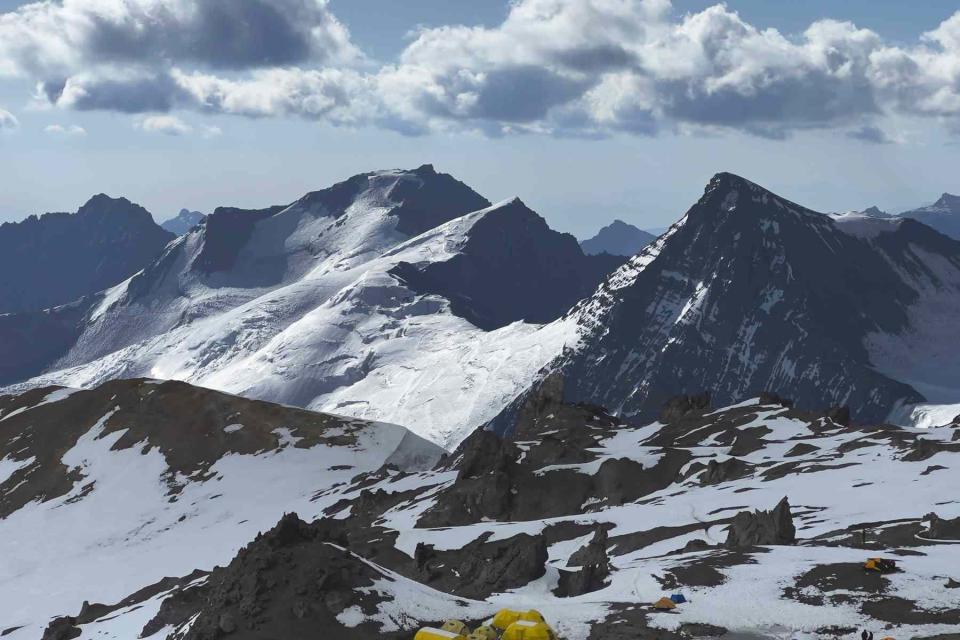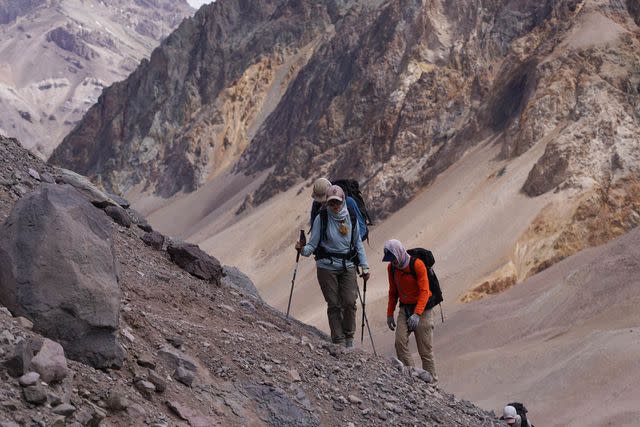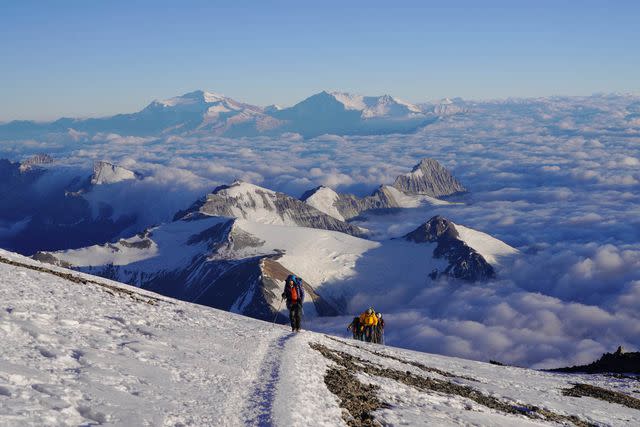I Climbed One of the Highest Mountains in the World Without Technical Hiking Experience — Here's How You Can, Too
Argentina’s Aconcagua is the highest peak outside Asia — and it's actually an achievable hiking goal.

Owen Clarke
For the uninitiated, the climbing world can seem daunting (and dangerous). But you don’t have to be on the level of Free Solo’s Alex Honnold to safely push your limits in the planet's highest places. Plenty of mountains around the world are accessible to beginner mountaineers, individuals without much more than a strong pair of legs, healthy lungs, and some determination.
In fact, the tallest mountain in the Americas, Aconcagua, falls into this category. At 22,838 feet, this Argentinian behemoth, the high point of the vast Andes range, is almost 10,000 feet taller than any mountain in the continental United States. It’s actually the tallest mountain anywhere in the world outside of Asia. This might sound intimidating, but unlike many other mountains of a similar elevation, under good conditions, Aconcagua’s standard route is nothing more than a hike. Climbers have to haul heavy loads up steep slopes, but typically no ropes, crampons, ice axes, or other “climbing gear” is needed, and there are no sections that require technical climbing.
If you’re a strong hiker with camping experience, Aconcagua presents an achievable goal — and perhaps the highest elevation on the planet that can be reached without technical climbing.
My dad and I spent a couple of weeks on the mountain in January, with my friend Damian Benegas of Benegas Brothers Expeditions. Damian and his twin brother, Willie, are legendary Argentinian guides and former professional climbers. Together they’ve summited Mount Everest 20 times, and Aconcagua over 100, not to mention dozens of other peaks on all seven continents. Damian and Willie began climbing on the mountain back in the late 1980s and were among those to pioneer commercial guiding on the peak. (In fact, Willie set a world record for the fastest climb and descent of the mountain in 2000, racing from the trailhead to the summit and back again in 23 hours and 30 minutes.) Today, their outfitter remains tight-knit — offering personalized, small-footprint expeditions — in contrast to other large-scale guiding operations on the mountain.
We flew into the balmy mountain town of Mendoza, awash with world-famous wineries, fine dining, and spas, where we spent a few days preparing gear for our trip. From Mendoza, we drove three hours west to Las Cuevas, a small mountain community just outside Aconcagua National Park, on the Chilean border. At 10,400 feet, Las Cuevas is the perfect point to acclimatize for an Aconcagua attempt. For several days we hiked up and down the surrounding peaks, trekking up to 14,000 feet as we became used to the thinner mountain air and harsh alpine sun.

Owen Clarke
Once adjusted to the higher elevation, we met up with mule drivers just outside the park, sending the bulk of our gear ahead on pack mules. (Damian and his team were filming a documentary, so we had hundreds of pounds of equipment with us.) Once we entered Aconcagua National Park, it took two days and 18 miles of hiking to reach Base Camp, traveling along the sprawling dried riverbed of the Horcones river valley, the mountains rising on either side. At one point, we crossed a small cable bridge used in the filming of Seven Years in Tibet. As we delved deeper into the valley, the mountains on either side grew ever higher, and the trail began to wind its way up cliff bands and through rocky defiles, ultimately reaching Plaza de Mulas (Base Camp) at 14,300 feet.
In this lofty alpine valley, at the foot of the Americas’ tallest peak, dozens of outfitters have set up a tent village, with coffee shops and bars, and even the world’s highest altitude art gallery. We stayed in a complex of tents and domes operated by BBE’s local outfitter for several days, preparing for the climb. The meals were exquisite, varied, and extensive, with enough food to leave me feeling stuffed to the gills each night. We feasted on hearty quinoa stews, sumptuous steaks, sausages, and grilled vegetables. There was plenty of fresh juice, beer and wine, of course, along with piping hot coffee and tea each morning.
After a few days of gorging ourselves on food at Base Camp, it was time to begin the real climb.
Some parties spend only four or five days on the mountain, traveling from Base Camp to Camp I, II, III, and the summit in consecutive pushes. Skilled climbers can even make it all the way to the top and back in a matter of hours. (In January 2022, American ultrarunner Tyler Andrews bolted from the trailhead to the summit in a mere seven hours and 35 minutes, a new record.)
We, on the other hand, spent 10 days going up and down the mountain from Base Camp, doing what mountaineers call “rotations.” First, we hiked up to Camp I (Plaza Canadá at 16,500 ft) and returned, then we hiked to Camp I, slept, hiked to Camp II (Nido de Cóndores at 18,200 ft), slept, and returned to Base. After a couple of rest days, we went for the summit, stopping at Camp II and Camp III (Plaza Cólera at 19,500 ft) for a night each before our summit push.
This back-and-forth system might seem redundant, but it helps dramatically with acclimatization, giving your body time to adapt to the lower concentrations of oxygen and preventing acute mountain sickness (AMS). Many climbers on Aconcagua go up too quickly and suffer from altitude sickness, which can lead to headaches, nausea, vomiting, and worse — delaying or destroying your chances at a summit.
Our six-person party, on the other hand, had no issues, thanks to our lengthy acclimatization period. Besides, each camp was well worth the stay, offering a unique vista on the vast array of peaks and valleys stretched out below this lofty summit, complete with sublime sunsets — the sky morphing into a warm haze of molten glass, flowing across the surrounding peaks. They were, without doubt, the best sunsets I’ve experienced.

Owen Clarke
On the summit day, we woke at 4 a.m. to begin climbing by 5:30. We took our time going up the mountain, switchbacking up steep snow slopes and trudging along narrow ridgelines, the pristine sunrise setting everything awash with orange, pre-dawn glow. Damian and his crew stopped in several sections to film and fly their camera drones, so we took longer than some parties, arriving at the summit in the early afternoon.
Clouds rolled in, so we couldn’t see much from the top, but there’s no feeling quite like standing on one of the world's highest mountains, regardless of what you can see. We wore crampons most of the day because was an unusual quantity of snow on the mountain, but the entire trip, from the trailhead to the summit, was nothing more than a long, steep (and jaw-droppingly beautiful) hike at high elevation. It was far from easy, that’s for sure, but it’s perfectly achievable without an ounce of rock or ice-climbing experience.
The best time to climb the mountain is during the peak of the Argentinian summer, December through February. These months usually offer the warmest, driest conditions. The full climbing season lasts from November to mid-March, however, and climbing earlier or later in the season may help with pricing and crowding, but weather conditions then are more unpredictable. Check out Benegas Brothers Expeditions' website to learn more and get in touch.
For more Travel & Leisure news, make sure to sign up for our newsletter!
Read the original article on Travel & Leisure.

